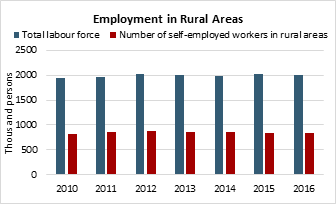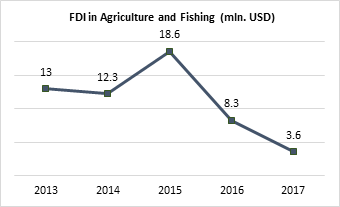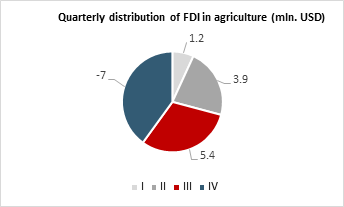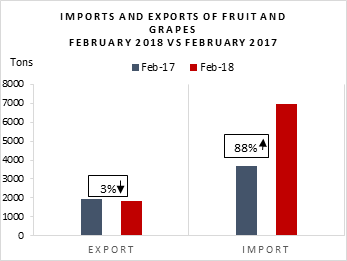The ISET Agri Review
ISET ECONOMIC INDICATORS is now producing the Agri Review, a glance at Georgia's agricultural sector developments.
PRODUCTION
Over the last decade, the real GDP of Georgia has been steadily increasing, while the share of agriculture has been decreasing. The share of agricultural output in total GDP decreased from 6.7% on 2016 to 6.2% in 2017. Agricultural output decreased in absolute terms as well by 2.6% in 2017 compared to 2016.
EMPLOYMENT
The active population (labor force) ranges from 1.9 mln to 2.0 mln persons, and 42%-44% out of the total labor force are self-employed people in rural areas. Given that in rural areas employment opportunities other than in agriculture are quite limited, most of self-employment in rural areas is likely to happen in the agricultural sector.
The share of FDI in agriculture constituted 0.2% of total FDI in 2017. While the total FDI in 2017 was higher than in 2016, FDI in agriculture has significantly decreased (by 56.6%). The highest FDI in agriculture was observed in the third quarter of 2017, while there was divestment (negative FDI) in the fourth quarter of 2017. Since FDI in agriculture is mostly driven by acquisition of land, recent restrictions on foreign ownership of agricultural land might be one cause of the reduction.

DOMESTIC PRICES
Overall, the price levels in the country have increased both on a monthly and annual basis; the Consumer Price Index (CPI) in February 2018 was 0.2% higher compared to January 2018, and 2.7% higher compared to February 2017.
In the category of food and non-alcoholic beverages, prices increased by 0.4%, contributing 0.13 percentage points to the overall CPI change. The main drivers were price changes in the following sub-groups:
From an annual perspective (February 2018 vs. February 2018), the prices of food and non-alcoholic beverages increased by 3.4%, contributing 1.04 percentage points to the annual inflation rate.
FRUIT AND GRAPES IN THE SPOTLIGHT
In February 2018, fruit and grapes became more expensive by 22.3% compared to February 2017. According to trade data, Georgia’s exports in this category slightly decreased by 3%, compared to the same period in the previous year. On the contrary, imports of fruit and grapes sharply increased by 88%, from 3701.58 tons to 6971.43 tons, during the same period. The current year was considered bad in terms of harvest in Georgia. Therefore, the high prices of fruit and grapes might be the result of decreased production, which caused a shortage in supply. In order to meet demand, Georgia increased its imports of fruits and grapes.

INTERNATIONAL PRICES
International prices slightly decreased in February 2018. The Food Price Index, measured by the Food and Agriculture Organization (FAO), dropped by 3% in February 2018, compared to the previous year. The main drivers were sugar and vegetable-oil prices. In February 2018, the FAO Vegetable Price Index lost 11.6% from February 2017, and the FAO Sugar Price Index showed the sharpest decrease at 33%.
TRADE HIGHLIGHTS
During February 2018, Georgia’s agricultural exports (including food) amounted to 49 mln USD, which is around 27% of total Georgian export value. While comparing this indicator to February 2017, it is 6% higher. As to imports, in February 2018 Georgia’s agro import stood at 85 mln USD, which constitutes 16% of total Georgian imports. Year over year (compared to February 2017), imports increased by 23%.
The Herfindahl-Hirschman Index (HHI), which ranges from zero to one, shows a country’s export/import diversification. A lower index value refers to high export/import diversification, while a higher value means more concentration (less diversification). Georgia’s agricultural exports by products are more diversified than its exports by countries. For the given period, the highest HHI for agricultural exports by products was observed in October 2017 (0.08), while the lowest (0.05) was observed in April 2017. HHI for agricultural exports by countries was the highest (0.15) in June, 2017 and the lowest (0.08) in September 2017.

IMPORT DIVERSIFICATION
The highest HHI for agricultural imports by products was observed in August 2017 (0.03), while the lowest (0.02) was in February 2017. The highest HHI for agricultural imports by countries was observed in February 2018 (0.13), while the lowest (0.1) was in January 2017.

POLICY WATCH
The Agricultural Project Management Agency (APMA) is considering establishing a separate agency responsible for the management of the agricultural insurance system in Georgia.
The introduction of a public-private partnership may have high potential for the long-run development of the agricultural insurance market in Georgia. However, this is conditional on the willingness of all parties involved to commit to this long-run process and invest the required resources (financial and intellectual). While a dedicated institution might do a better job in terms of the capacity building necessary for the successful implementation of agricultural insurance, there is the so-called “greenfield risk” because, typically, a new institution has to build trust among stakeholders.
For more information follow the link: http://apma.ge/projects/read/agroinsurance/4:parent
The APMA launched the new project “Young Entrepreneur,” funded by DANIDA, to support young people from rural areas in Georgia.
The project will have three stages: technical assistance during application process, co-funding from APMA, and technical assistance after co-funding. The program targets women aged 18-40 and men aged 18-35. Given that the unemployment rate among these age categories is the highest in Georgia, the initiative is expected to have a positive impact on employment figures. However, as in case of other subsidized programs, it is vital to ensure the sustainability of the initiative and have clear phase-out strategy, as well as a strong monitoring component.
For more information follow the link: http://danida.apma.ge









